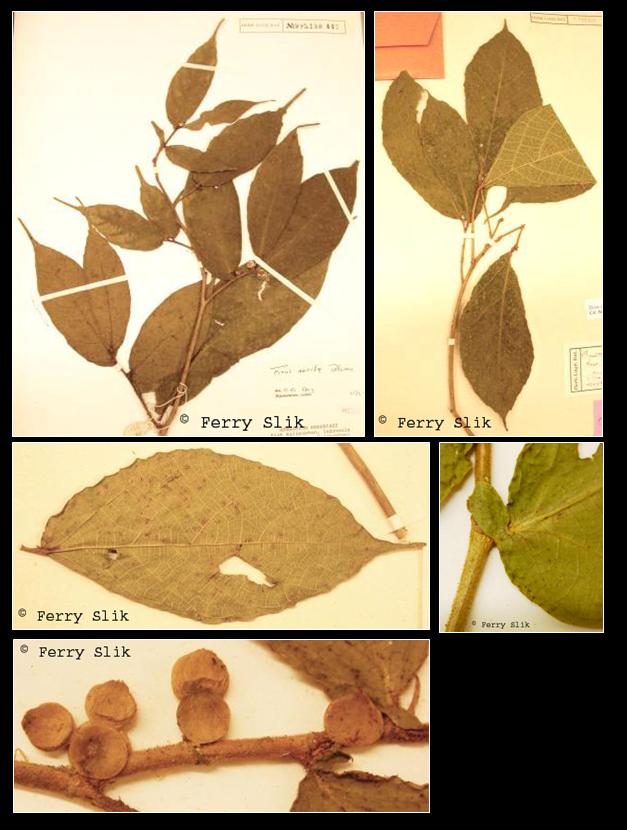Ficus aurita Reinw. ex Blume, Bijdr. (1825)
Latin for 'eared', referring to the ear-like appendages at the leaf base.Synonyms
Ficus auriculifera Merr.
Ficus aurita var. auriculifera (Merr.) Corner
Ficus aurita var. celebica (Blume) Corner
Ficus celebica Blume
Ficus hispidulosa Elmer
Diagnostics
Understorey tree up to 13 m tall and 25 cm dbh. Stem with white sap.
Stipules ca. 15 mm long, hairy. Leaves alternate, simple, penni- to tripli-veined,
hairy below, base often with ear-like appendage, margin toothed. Fruits ca. 7 mm
diameter, yellow-orange-red, globose, fleshy figs, placed along the twigs.
Description
Dioecious shrub or small tree, up to 13 m tall. Twigs up to 0.2 cm thick, angled, soft-hairy.
Stipules paired, lanceolate, up to 2 cm long, hairy, persistent or caducous. Leaves distichous,
thin-coriaceous, soft-hairy below; elliptic to lanceolate, 7.5-23.5 x 2.3-11 cm, base asymmetric,
cuneate, distinctly auriculate or not, margin slightly toothed or incised, apex acuminate, acumen
2-3 cm long; midrib raised above, with a gland at the base below; lateral veins 4-8 pairs, raised
below, faint above, basal pairs short, departing at a broad angle from the midrib; intercostal
venation reticulate, visible below, invisible above; petiole up to 1 cm long, hairy. Syconia
axillary, solitary, fulvous hairy, ripening orange to red, globose or ellipsoid, up to 0.6 cm
diameter, apex umbonate; lateral bracts 1-2; internal bristles absent. Tepals 3-4, white,
glabrous, entire or with toothed margin, free. Achenes up to 1 mm long, slightly compressed,
distinctly keeled at the apex. [from Tree Flora of Sabah and Sarawak]
Ecology
In undisturbed mixed dipterocarp to sub-montane forests up to 1600 m
altitude. Often along rivers and streams, but also on hillsides and ridges.
Usually on limestone soils.
Distribution
Borneo, Philippines, Celebes, Moluccas, New Guinea.
Local names
Borneo: Punoh (Kelabit).
